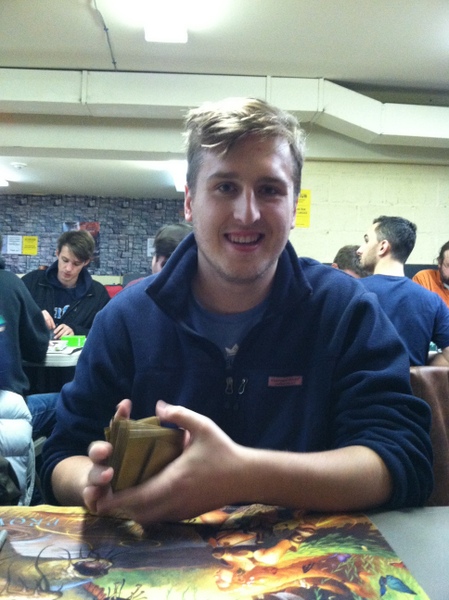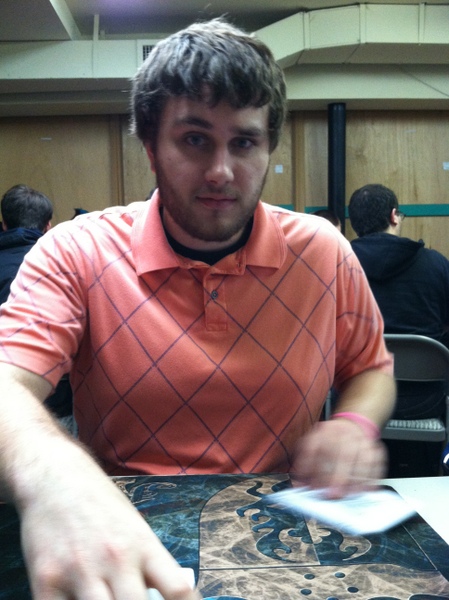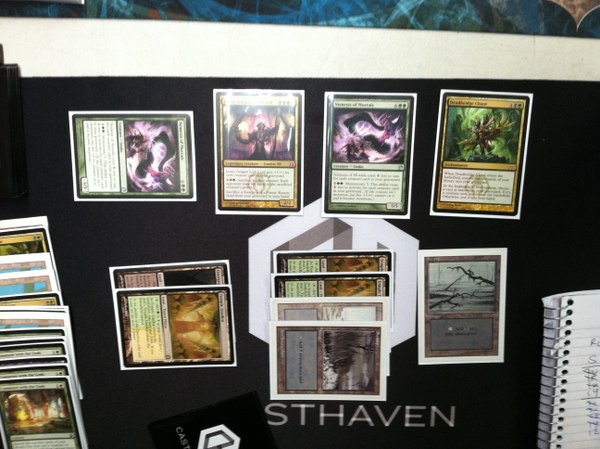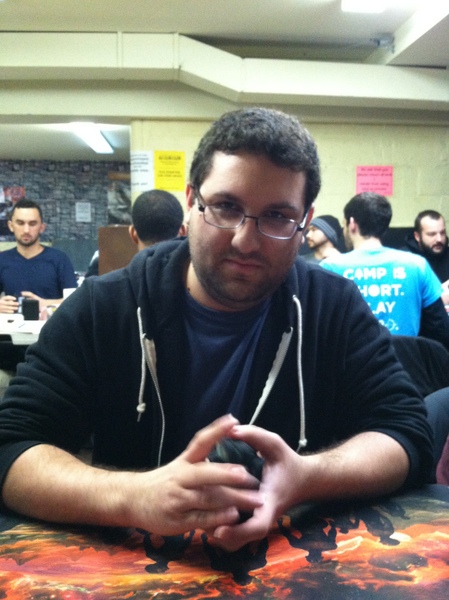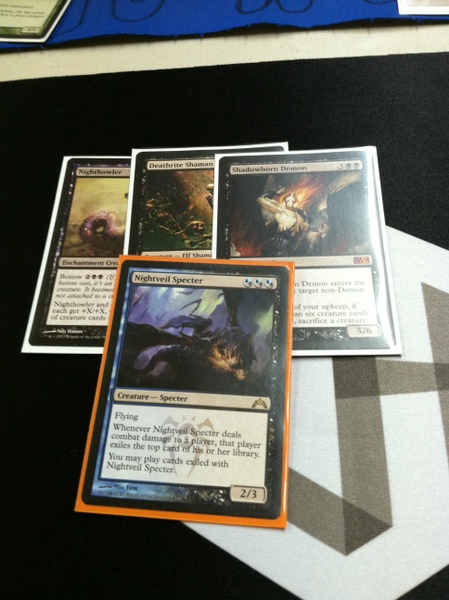Variance.
Last week I spent the first half of my article talking about the way in which good players can mitigate the effects of negative variance. I also wrote about how easy it is to use luck as a crutch, to discount play skill when thinking about your losses. I lost because my opponent topdecked the perfect card. I lost because I drew lands five turns in a row. I lost because my opponent is member of the unconditional elect and possesses efficacious grace whereas I have been cursed by God to live in the shadows of my saved brethren. I haven’t actually heard the last one yet, but I’m hoping to someday play a sore losing Calvinist who might say something along those lines. Anyway, what I left out last week was how good decks can sidestep variance by playing the best cards. While I do believe Huey Jensen could top eight an SCG open with an actual ham sandwich, I think his job is made significantly easier by playing a powerful deck that is fine-tuned to the meta. If you are playing the Anthousa’s Army Intro deck at a PTQ, I would argue that regardless of your play skill, you are probably still going to lose to opponents who don’t have cards like Setessan Battle Priest and Vanquish the Foul in their constructed decks. Anyway, this is all common sense stuff, I only bring it up as a starting point for talking about my record with BG Dredge.
Last week, I 4-0’ed my weekly Standard event with the deck. I attributed the fact that I had done well on the deck being good; BG Dredge is an extremely synergistic graveyard based deck in a format where there is very little graveyard hate. The deck has a recursive threat in Jarad, inevitability in Deathrite Shaman, and a bunch of cheap beaters which will end the game if left unchallenged. Yet, the deck isn’t very disruptive in stopping opponents’ game plans. I was able to win my games last week by drawing well and being able to pose enough durable threats that my opponents were put on the back foot. However, this deck is pretty bad when it needs to deal with a problematic permanent an opponent plays. Blood Baron of Vizkopa, Elspeth, Master of Waves, Desecration Demon, Pack Rat, and hell, even Nightveil Specter can pose serious problems for this deck. If your opponent plays a turn four Desecration Demon, you either need to constantly sacrifice creatures in order to keep it tapped down or play the most insane Drown in Filth ever.
Which brings me to my next point; Drown in Filth is terrible. On paper it may seem like it’s not the worst thing ever; it’s a removal spell in a deck that is desperate for removal that also contributes to the dump-stuff-in-the-graveyard plan. Yet, the problem is that when it misses, which it often does, you just played a worse Tome Scour on yourself. The card seems especially bad when considering the decks extremely low land count or that you might want to use the lands already in your graveyard to make mana with Deathrite Shaman. For every time Drown in Filth kills a Nightveil Specter, perhaps while also milling a Jarad which makes your Nemesis of Mortals castable that turn, there are two times it doesn’t actually kill anything and you end up dumping something you’d rather have in your hand.
GB Dredge also suffers from the problem of bad mulligans. In his article about the deck, Conley writes, “Opening hands are very important, and the deck is quite forgiving to mulligans—so when in doubt, ship it.” I have to respectfully disagree here. While opening hands are undoubtedly important, the deck just has a lot of awkward draws. The low land count makes for many land light hands, many of the cards are mana intensive (Jarad I’m looking at you) but you only have four lands that create both black and green, Nighthowler and Deathrite don’t do much of anything until you play a Mulch spell, and often times you have to make awkward decisions while casting a Grisly Salvage as to whether you want mana dorks to cast spells or actual good creatures to play in hopes to eventually casting them. Perhaps, I do need more practice with the deck, but I felt that my six card hands were rarely more acceptable than the seven I shipped.
Before I start talking about my games this week at Pandemonium Books & Games, here is the deck list I played for reference:
BG Dredge 12/5 Update
Creatures (30)
4 Deathrite Shaman
4 Elvish Mystic
3 Jarad, Golgari Lich Lord
4 Lotleth Troll
1 Manaweft Sliver
4 Nemesis of Mortals
4 Nighthowler
2 Shadowborn Demon
4 Sylvan Caryatid
Spells (11)
4 Commune with the Gods
3 Drown in Filth
4 Grisly SalvageLands (19)
4 Forest
4 Overgrown Tomb
7 Swamp
4 Temple Garden
Sideboard (15)
2 Deadbridge Chant
3 Golgari Charm
1 Hero's Downfall
2 Shadowborn Demon
3 Sin Collector
4 Skylasher
You’re reading it correctly, the Temple Gardens are in there strictly to cast Sin Collector out of the sideboard. While I understand the desire to have a high creature count to make the deck work, messing up the manabase to jam additional creatures just doesn’t seem worth it. Woods’ admittedly realized his mistake in his last incarnation of the deck and took out the Sin Collectors in favor of maindeck Thoughtseizes. This of course didn’t help me when I was playing last Wednesday and found myself taking unnecessary damage from Temple Garden, but that’s the way it goes. Another thing to note about the deck is how many cards are dedicated to fighting against Mono-Blue Devotion.The full set of Skylashers in the sideboard are almost exclusively for the azure menace, yet, I’m not entirely convinced that this deck is so terrible against Mono-Blue Devotion that it needs four lashers, some Golgari Charms, and another two Shadowborn Demons in the sideboard to beat it. I would rather see the four Skylasher as a card that is a bit more disruptive and good in multiple match-ups; perhaps a split of Nyleas’ Disciple for the aggro match-ups and Lifebane Zombies for Boros, Orzhov Midrange, and Jund, would do the trick. Keep in mind that my meta seems to have very few Mono-Blue Devotion Decks floating around and that I’m making this suggestion in part because I only played against Mono-Blue once in the past two months.
Round 1—Alex with UW Control (0-2)
Alex was frantically searching for a Quicken before the event, so I assumed his was on UW Control. Having not played the match-up before, I assumed that it was bad for me. I later realized that it was actually way worse than bad.
Game one, Alex played a turn two Ratchet Bomb and I found it extremely difficult to play around. Knowing that Alex was also packing four Supreme Verdicts, I found myself in the position where I didn’t want to commit too many threats to the board but needing to pressure him all the same. Anyway, I played some creatures, Alex popped the Ratchet Bomb, then played Supreme Verdict, drew a million cards with Sphinx’s Revelation and countered every relevant threat I had. I made a little promise to myself then and there that I would go back to playing UW Control next week. Alex ended up winning the game with Elspeth.
Sideboard:
-3 Drown in Filth
-2 Shadowborn Demon
-1 Nemesis of Mortals
-2 Elvish Mystic
+3 Sin Collector
+2 Deadbridge Chant
+3 Golgari Charm
+1 Hero’s Downfall
Here I took out anything that targeted creatures, since Alex didn’t have them, and shaved down some mana dorks and a Nemesis. I boarded in anything that could disrupt his game plan or help me keep pace in the long game. I imagined myself using one Golgari Charm to save my creatures from Supreme Verdict, another to blow up a Detention Sphere, and the last to kill Elspeth Tokens, but this was not to be.
Game two, I mulliganed down to five and ended up keeping a hand with two black sources and nothing I could play. I ended up scooping up my cards after I failed to draw a green source for several turns and Alex hit all of his land drops and started messing around with Jace.
Round 2—Eric with Jund Midrange (2-0)
Game one, Alex played a Sylvan Caryatid into a turn three Reaper of the Wilds. I sniped the Reaper while he was tapped out with Shadowborn Demon. Eric just drew lands for the rest of the game while I played out Jarad and a Nemesis of Mortals which helped to end the game shortly afterward.
Sideboard:
-2 Shadowborn Demon
-3 Drown in Filth
+2 Sin Collector
+2 Deadbridge Chant
+1 Hero’s Downfall
Despite the fact that Shadowborn Demon had been good for me in the first game, I was worried that it didn’t hit enough of his creatures to warrant keeping in the maindeck. I believe this was a mistake on my part since most Jund Decks don’t play Desecration Demon at this moment and have a bunch of creatures that can be taken out by Shadowborn including Stormbreath Dragon, Polukranos, or the necro-muncher himself Scavenging Ooze. Drown in Filth, however, seems fine to side out since it doesn’t do a particularly good job of killing any of the creatures in Jund. Sin Collector comes in to deal with the plethora of instant and sorcery speed disruption in the Jund arsenal, Deadbridge Chant helps play the grindy game, and Hero’s Downfall seemed like a decent enough removal spell to replace Drown in Filth.
Game two, Eric played a turn one Thoughtseize and saw my questionable keep of two lands, two Nemesis of Mortals, Deadbridge Chant, Commune with Nature, and Jarad. Eric unsurprisingly took the the Commune. Then Eric got stuck on two lands while I drew a Grisly Salvage and had all of my prayers answered. My board state at the end of the game looked this this:
Round 3—Roberto with Selesnya Aggro (1-2)
Game one, I mulliganed to a six lander with four lands and two Elvish Mystics. I know I should have gone to five, but felt that if I drew any threat or dig spell, I would be in this game. Instead I drew lands while Roberto slammed me with Experiment One, Soldier of the Pantheon, Loxodon Smiter, and a Boon Satyr.
Sideboard:
-1 Manaweft Sliver
-1 Commune with the Gods
-1 Jarad, Golgari Lich Lord
+2 Shadowborn Demon
+1 Golgari Charm
Here I shaved a few cards to make room for additional removal. Shadowborn kills just about everything in GW, can attack over their creatures, and can profitably block as well. I liked the one of Golgari Charm to kill Soldier of the Pantheon and Experiment One while also blowing up Boon Satyr.
Game two, my notes show that we had a board stall and that my two Deathrite Shaman dealt 17 damage this game.
Game three, I mulliganed a hand with no green mana into a hand with no black mana. I ended up keeping it and being punished when Roberto had a fast draw and I had to use my clean-up step to discard a bunch of GB spells.
Round 4—Ben with Mono Black Devotion (1-2)
Ben was actually excited to play me despite the fact that we were in the 1-2 bracket. Thanks for reading the column Ben! I’m sorry that most of our games are abysmal affairs where we just mulligan a bunch.
Game one, Ben played a Nightveil Specter which quickly took over the game. Ben would attack with the Specter, it would yield a backbreaking card, he would play it, then I would take my turn and draw a land. It was pretty easy for Ben to beat me when his Specter allowed him to play these guys from my deck:
Sideboard:
-3 Drown in Filth
-1 Shadowborn Demon
+2 Deadbridge Chant
+1 Sin Collector
+1 Golgari Charm
I am still not sure on how to sideboard for the Mono Black match-up so I just used Conley’s strategy.
Game two, Ben mulliganed to five and decided to keep the no-lander on the draw. I won this one.
Game three, I mulliganed down to five and kept a one-lander on the draw. I lost this one.
Playing GB Dredge has yielded my best and worst record at Pandemonium. The deck is certainly cool, and capable of some really powerful plays, but struggles with most of the tier-one decks in the format. I don’t see how Dredge ever wins against UW or Esper Control and don’t see it as being more than 50% against Mono Black Devotion. Perhaps this particular build is suited to beat Mono-Blue, but even then, I still don’t think you’re that favored. Ultimately, Dredge seems like a bit of a novelty deck, it’s better than it looks on paper but probably still not good enough to put up any substantial finishes in this Standard environment. I would recommend this deck to people who are looking for something fun and different but not to anyone who is looking for the next metagame crusher.
If I had to play this deck again this week this would be my 75:
BG Dredge Last Attempt
Creatures (29)
4 Deathrite Shaman
4 Elvish Mystic
2 Jarad, Golgari Lich Lord
1 Voyaging Satyr
4 Lotleth Troll
4 Nemesis of Mortals
4 Nighthowler
2 Shadowborn Demon
4 Sylvan Caryatid
Spells (11)
4 Commune with the Gods
4 Grisly Salvage
3 ThoughtseizeLands (20)
8 Forest
4 Overgrown Tomb
7 Swamp
1 Golgari Guildgate
Sideboard (15) (15)
2 Deadbridge Chant
3 Golgari Charm
1 Hero's Downfall
2 Shadowborn Demon
2 Whip of Erebos
1 Plummet
2 Nylea’s Disciple
2 Lifebane Zombie
Next week I will tackle Wednesday Night Magic and a Maxpoint Silver event with Huey Jensen’s beautiful UW Control build that features one Elspeth and one Elixir of Immortality as its win conditions:
Azorius Control
Spells (34)
1 Elspeth, Sun’s Champion
3 Jace, Architect of Thought
4 Azorius Charm
4 Detention Sphere
4 Dissolve
4 Divination
1 Elixir of Immortality
2 Quicken
1 Ratchet Bomb
4 Sphinx’s Revelation
4 Supreme Verdict
2 SyncopateLands (26)
4 Azorius Guildgate
4 Hallowed Fountain
8 Island
2 Mutavault
8 Plains
Sideboard (15)
1 Blind Obedience
3 Fiendslayer Paladin
3 Gainsay
1 Jace, Memory Adept
3 Last Breath
2 Negate
1 Pithing Needle
1 Ratchet Bomb
At age 15, while standing in a record store with his high school bandmates, Shawn Massak made the uncool decision to spend the last of his money on a 7th edition starter deck (the one with foil Thorn Elemental). Since that fateful day 11 years ago, Shawn has decorated rooms of his apartment with MTG posters, cosplayed as Jace, the Mindsculptor at PAX, and competes with LSV for the record of most islands played (lifetime). When he’s not playing Magic, Shawn works as a job coach for people with disabilities, plays guitar in an indie-pop band, and keeps a blog about pro-wrestling.


